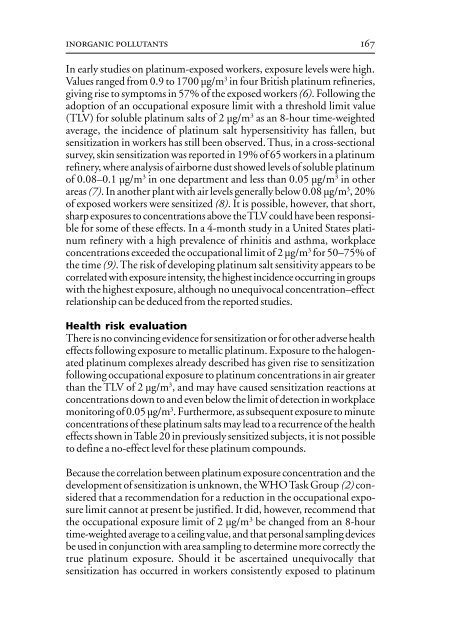Air Quality Guidelines - World Health Organization Regional Office ...
Air Quality Guidelines - World Health Organization Regional Office ...
Air Quality Guidelines - World Health Organization Regional Office ...
Create successful ePaper yourself
Turn your PDF publications into a flip-book with our unique Google optimized e-Paper software.
inorganic pollutants<br />
167<br />
In early studies on platinum-exposed workers, exposure levels were high.<br />
Values ranged from 0.9 to 1700 µg/m 3 in four British platinum refineries,<br />
giving rise to symptoms in 57% of the exposed workers (6). Following the<br />
adoption of an occupational exposure limit with a threshold limit value<br />
(TLV) for soluble platinum salts of 2 µg/m 3 as an 8-hour time-weighted<br />
average, the incidence of platinum salt hypersensitivity has fallen, but<br />
sensitization in workers has still been observed. Thus, in a cross-sectional<br />
survey, skin sensitization was reported in 19% of 65 workers in a platinum<br />
refinery, where analysis of airborne dust showed levels of soluble platinum<br />
of 0.08–0.1 µg/m 3 in one department and less than 0.05 µg/m 3 in other<br />
areas (7). In another plant with air levels generally below 0.08 µg/m 3 , 20%<br />
of exposed workers were sensitized (8). It is possible, however, that short,<br />
sharp exposures to concentrations above the TLV could have been responsible<br />
for some of these effects. In a 4-month study in a United States platinum<br />
refinery with a high prevalence of rhinitis and asthma, workplace<br />
concentrations exceeded the occupational limit of 2 µg/m 3 for 50–75% of<br />
the time (9). The risk of developing platinum salt sensitivity appears to be<br />
correlated with exposure intensity, the highest incidence occurring in groups<br />
with the highest exposure, although no unequivocal concentration–effect<br />
relationship can be deduced from the reported studies.<br />
<strong>Health</strong> risk evaluation<br />
There is no convincing evidence for sensitization or for other adverse health<br />
effects following exposure to metallic platinum. Exposure to the halogenated<br />
platinum complexes already described has given rise to sensitization<br />
following occupational exposure to platinum concentrations in air greater<br />
than the TLV of 2 µg/m 3 , and may have caused sensitization reactions at<br />
concentrations down to and even below the limit of detection in workplace<br />
monitoring of 0.05 µg/m 3 . Furthermore, as subsequent exposure to minute<br />
concentrations of these platinum salts may lead to a recurrence of the health<br />
effects shown in Table 20 in previously sensitized subjects, it is not possible<br />
to define a no-effect level for these platinum compounds.<br />
Because the correlation between platinum exposure concentration and the<br />
development of sensitization is unknown, the WHO Task Group (2) considered<br />
that a recommendation for a reduction in the occupational exposure<br />
limit cannot at present be justified. It did, however, recommend that<br />
the occupational exposure limit of 2 µg/m 3 be changed from an 8-hour<br />
time-weighted average to a ceiling value, and that personal sampling devices<br />
be used in conjunction with area sampling to determine more correctly the<br />
true platinum exposure. Should it be ascertained unequivocally that<br />
sensitization has occurred in workers consistently exposed to platinum

















